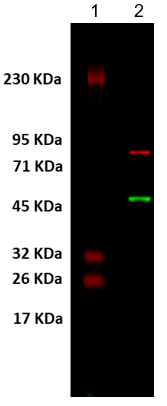Maximum quantity allowed is 999
Fluorescent-labeled Secondary Antibodies and Streptavidins
Application: Immunofluorescence Staining

(Laser Scanning Microscope: Olympus FLUOVIEW FV 3000)
Green: α-Tubulin,Blue: Nuclear DNA
The HeLa cells were fixed with 4% paraformaldehyde, and permeabilized with 0.1% Triton X-100.
Then, the specimen was blocked in BSA/PBS blocking buffer.
Subsequently, the specimen was incubated with properly diluted primary antibody (Mouse Anti α-Tubulin IgG). And, after washing, was further incubated with biotin-conjugated secondary antibody (Goat Anti-Mouse IgG Biotin Conjugate [G0387]).
Finally, it was rinsed with PBS and stained with each fluorescent-probe*.
*Streptavidin FITC Conjugate [S0966] at 5 µg/mL (shown in green), DAPI·2HCl [A2412] at 1 µg/mL (shown in blue)

(Laser Scanning Microscope: Olympus FLUOVIEW FV 3000)
Red: α-Tubulin, Green: Endoplasmic Reticulum, Blue: Nuclear DNA
The HeLa cells were fixed with 4% paraformaldehyde, and permeabilized with 0.1% Triton X-100. Then, the specimen was blocked in BSA/PBS blocking buffer.
Subsequently, the specimen was incubated with properly diluted primary antibody (Mouse Anti α-Tubulin IgG and Rabbit Anti KDEL** IgG).
Finally, it was rinsed with PBS and stained with each fluorescent-probe***.
** KDEL (amino acid sequence) normally localize in the endoplasmic reticulum.
*** Goat Anti-Mouse IgG R-PE Conjugate [G0569] at 5 µg/mL (shown in red),
Goat Anti-Rabbit IgG FITC Conjugate [G0452] at 5 µg/mL (shown in green),
Hoechst 33258 [H1343] at 1 µg/mL (shown in blue)
Application: Flow Cytometry

(Flow cytometer: Sysmex RF-500)
The HeLa cells were incubated with Mouse Anti CD9 Antibody (red line) or Mouse IgG2aκ isotype control (black line) at 5 µg/mL.
Subsequently, both were stained with Goat Anti-Mouse IgG FITC Conjugate [G0406] at 5 µg/mL.
Application: Fluorescent Western Blotting

(Imager: Cytiva Amersham Imager 680)
Red: Calnexin, Green: α-Tubulin
Lane 1: Color Protein Marker, Lane 2: HeLa Whole Cell Lysate at 5 µg
Transfer of HeLa cell lysate to PVDF membrane. Then, the specimen was blocked in BSA/TBST blocking buffer.
Subsequently, the specimen was incubated with properly diluted primary antibody (Mouse Anti Calnexin IgG and Rabbit Anti α-Tubulin ).
Finally, it was rinsed with TBST and stained with each fluorescent-probe*.
*Goat Anti-Rabbit IgG FITC Conjugate [G0452] at 5 µg/mL(shown in green)
Goat Anti-Mouse IgG R-PE Conjugate [G0569] at 2 µg/mL (shown in red)
Products
- T3885
- Streptavidin R-PE Conjugate (red fluorescence)
- A2412
- DAPI 2HC (blue fluorescence)
- D5888
- DAPI 2HCl (0.2mL×5) (1mg/mL in Water) [for Cell Staining] (blue fluorescence)
- H1343
- Bisbenzimide H 33258 Hydrate (blue fluorescence)
- B6236
- Bisbenzimide H 33258 (1mg/mL in Water) (0.2mL×5) [for Cell Staining] (blue fluorescence)
Cell Proliferation Assay Reagent

Resazurin, when added to viable cells, is reduced by the cellular enzymatic or chemical reactions converting blue/non-fluorescent resazurin to highly fluorescent resorufin.
The assay is simple to perform since the indicator is water-soluble and has low toxicity, thus eliminating the washing/fixing and extraction steps required in other commonly used cell proliferation assays.

Product
Dead Cell Staining Dye
Acridine orange is a nucleic acid staining dye that is used to identify dead cells. It intercalates with the double-stranded DNA base pairs at a ratio of 1:3 and is capable of emitting green fluorescence (Ex: 500 nm, Em: 520 nm). It also emits red fluorescence (Ex: 460 nm, Em: 650 nm) when bound to RNA or single-stranded DNA. Since acridine orange is mutagenic, this product is supplied as a solution that prevents it from splashing during weighing.
Product
Application: The method of staining cells by A3396

NIH3T3 cells stained by A3396
- Remove the medium from the culture plate and wash the cells twice with cold PBS(-). Remove the PBS(-).
- Add PBS(-) and Acridine Orange solution [A3396] (1/50th of the volume of the added PBS(-)) and incubate for 15 minutes.
- Remove the staining solution and wash the cells twice with PBS(-).
- Add PBS(-) and observe the cells under a fluorescence microscope.
Please adjust the staining duration and the volume of the solution according to the cell density.
Some cells may require prior fixation; therefor optimization of the protocol according to your need is recommended.

λDNA was stained using either the acridine orange solution [A3396] or the other manufacturer's product, and the fluorescence measured from two experiments was compared (Ex:500nm, Em:520nm).
The results indicated that A3396 stained better than the other manufacturer's product.
Chemiluminescence Reagent for the Detection of Superoxide in Mitochondria

Figure. Fluorescence in mitochondria in mouse peritoneal neutrophils. (Provided by Prof. Kobayashi)
S. Sasaki, S. Yamada, M. Iwamura, Y. Kobayashi, Free Radic. Biol. Med. 2013, 65, 1005.
